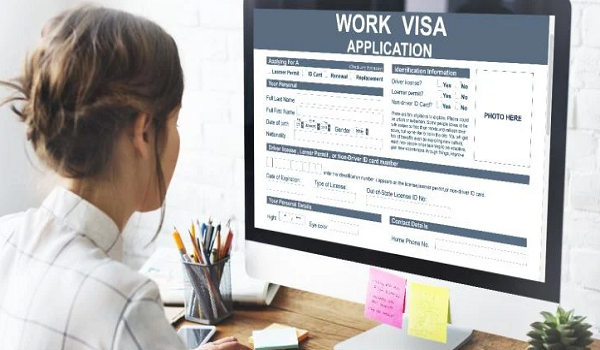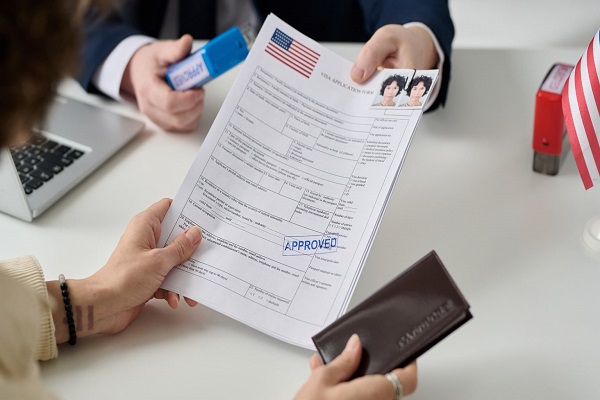The Permanent Work Visa USA is a highly sought-after immigration pathway for foreign nationals who aspire to live and work in the United States on a long-term basis. It provides lawful permanent residency, commonly known as a Green Card, allowing individuals to reside and work in the U.S. indefinitely.
A Permanent Work Visa USA, also commonly known as an employment-based immigrant visa, is a legal document that grants foreign nationals the privilege of living and working in the United States on a permanent basis. This highly sought-after visa category is designed to attract and retain individuals with specific skills, talents, and employment prospects, contributing to the country’s economic growth and diversification. The Permanent Work Visa USA program encompasses several distinct visa categories, each catering to different professional and employment backgrounds, but all share the common goal of providing a pathway to permanent residency for foreign workers.
The Permanent Work Visa USA program plays a vital role in shaping the nation’s workforce and sustaining its position as a global economic leader. It welcomes individuals from diverse fields, including technology, healthcare, business, and arts, offering them the opportunity to establish long-term roots in the United States. This program, often referred to as the “green card” process, holds the promise of not only a secure and stable employment future but also the potential for eventual U.S. citizenship.
As the demand for Permanent Work Visas USA remains high and the application process can be complex, it is essential for foreign nationals and their prospective employers to understand the different visa categories, eligibility criteria, and the steps involved in obtaining this coveted status. This post will provide an overview of the various visa categories, the benefits of holding a Permanent Work Visa USA, and the requirements for securing this status, ensuring that individuals seeking to make the United States their permanent home are well-informed and adequately prepared to embark on this life-changing journey.
Let’s proceed…
The Permanent Work Visa USA
A Permanent Work Visa in the United States typically refers to an immigrant visa that allows foreign nationals to live and work in the U.S. on a permanent basis. The most common type of permanent work visa in the U.S. is the employment-based immigrant visa, also known as a green card.
It’s called a “permanent” visa because it doesn’t expire like other visas that need renewing. Getting a Permanent Work Visa is a big step for people from other countries who want to live and work in the United States for a long time, either for their job or to be with their family.
Types Of Permanent Work Visa USA
The United States offers several types of permanent work visas for foreign nationals seeking to live and work in the country on a long-term basis. These visas, also known as immigrant visas, provide individuals with the opportunity to establish permanent residency in the U.S. and, eventually, become eligible for U.S. citizenship. Each type of permanent work visa serves a distinct purpose and is designed for specific categories of immigrants. Below, I will provide an extensive overview of some of the most common types of permanent work visas in the United States.
1. Employment-Based Green Cards:
The majority of permanent work visas in the U.S. are based on employment. These visas are divided into several preference categories:
a. EB-1 Priority Workers:
Reserved for individuals with extraordinary ability in sciences, arts, education, business, or athletics, as well as outstanding professors, researchers, and multinational executives.
- No labor certification required
- Fastest processing among employment-based visas
b. EB-2 Professionals with Advanced Degrees:
This category targets professionals with advanced degrees (master’s or higher) or exceptional ability in sciences, arts, or business.
- National Interest Waiver (NIW) available for self-petition
- Labor certification generally required
c. EB-3 Skilled Workers, Professionals, and Other Workers:
Designed for skilled workers (with at least two years of experience), professionals (with bachelor’s degrees), and unskilled labor.
- Longer processing times than EB-1 and EB-2
- Requires labor certification and employer sponsorship
d. EB-4 Special Immigrants:
This category includes religious workers, broadcasters, members of the U.S. Armed Forces, and other special categories.
- Some subgroups are exempt from labor certification
- Limited availability
e. EB-5 Immigrant Investors:
This visa is for foreign investors who invest $800,000–$1,050,000 in U.S. commercial enterprises and create at least 10 full-time jobs.
- No employer sponsorship or labor certification
- Direct path to Green Card and citizenship
2. Family-Sponsored Green Cards:
U.S. citizens and permanent residents can sponsor certain family members for green cards. These include spouses, children, parents, and siblings, with preferences based on the relationship and the sponsor’s status.
3. Diversity Visa (DV) Lottery Program:
The DV lottery program, also known as the green card lottery, is a unique way for individuals from countries with low rates of immigration to the U.S. to apply for a green card. This program provides a limited number of green cards each year through a random selection process.
4. Special Immigrant Visas:
These visas are designed for individuals who do specific types of work or face certain circumstances. For example, special immigrant visas are available for Afghan and Iraqi nationals who have assisted the U.S. government, as well as international broadcasters.
5. Refugee or Asylee Adjustment:
Individuals who have been granted refugee or asylee status in the U.S. can apply for a green card one year after their status is granted.
6. Employment-Based Conversion:
Some non-immigrant visa holders in the U.S., such as H-1B or L-1 visa holders, may be eligible to apply for a green card through their employment sponsor.
7. Employment-Based Self-Petition:
Certain individuals with extraordinary abilities or who have suffered abuse or extreme cruelty can self-petition for a green card without the need for an employer sponsor.
8. Immediate Relatives of U.S. Citizens:
Spouses, unmarried children under 21, and parents of U.S. citizens are considered immediate relatives and can apply for green cards without being subject to numerical limitations.
Permanent Work Visa USA Requirements
Obtaining a Permanent Work Visa USA is a significant step for foreign nationals who wish to live and work in the United States on a long-term basis. Commonly known as the “Green Card,” this visa provides a path to permanent residency and, eventually, U.S. citizenship. However, the process can be complex, and applicants must meet specific requirements to be eligible. In this comprehensive guide, we will delve into the key requirements and steps involved in applying for a Permanent Work Visa USA.
Key Requirements for a Permanent Work Visa USA:
1. Employment-Based Categories:
To qualify for a Permanent Work Visa USA, individuals must fall into one of the employment-based categories, such as:
- Employment First Preference (EB-1): Priority Workers, including extraordinary ability, outstanding professors and researchers, and multinational executives and managers.
- Employment Second Preference (EB-2): Individuals with advanced degrees or exceptional ability.
- Employment Third Preference (EB-3): Skilled workers, professionals, and other workers.
- Employment Fourth Preference (EB-4): Special immigrants, including religious workers and broadcasters.
- Employment Fifth Preference (EB-5): Investors who create jobs in the U.S.
2. Job Offer:
Applicants typically need a job offer from a U.S. employer to begin the Green Card application process. The employer may need to demonstrate that no qualified U.S. workers are available for the position.
3. Labor Certification:
In some cases, employers are required to obtain a labor certification from the U.S. Department of Labor to demonstrate that the foreign worker will not negatively impact the U.S. labor market.
4. Eligibility Criteria:
Depending on the employment category, applicants may need to meet specific eligibility criteria, such as having exceptional skills, advanced degrees, or substantial investment capital.
5. Financial Requirements (EB-5):
Investors applying for the EB-5 visa must invest a significant amount of capital in a new commercial enterprise and create jobs for U.S. workers.
6. Background Checks and Inadmissibility:
Applicants must undergo background checks, and certain criminal records or security concerns may result in inadmissibility.
7. Immigration Petition:
The employer or the applicant may file an immigrant petition, such as Form I-140 (Employment-Based) or Form I-526 (EB-5), to begin the application process.
8. Visa Bulletin:
Applicants must monitor the Visa Bulletin published by the U.S. Department of State to determine when they can proceed with their Green Card application. Priority dates are crucial.
9. Adjustment of Status or Consular Processing:
Once a visa number becomes available, applicants can either adjust their status within the U.S. (if eligible) or undergo consular processing at a U.S. embassy or consulate abroad.
10. Medical Examination and Biometrics:
Applicants are required to undergo a medical examination and provide biometrics information as part of the application process.
11. Fees and Documentation:
A variety of fees, forms, and supporting documentation are required during the application process, including proof of identity, relationship documents (if applicable), and financial documentation.
12. Affidavit of Support:
Many Green Card applicants will need a qualifying U.S. sponsor to submit an Affidavit of Support (Form I-864) to ensure they won’t become a public charge.
Documents Required When Applying For Permanent Work Visa USA
Applying for a permanent work visa in the United States typically involves several steps and the submission of various documents. The specific documents you need may vary depending on the type of visa you are applying for, such as an employment-based immigrant visa (e.g., EB-1, EB-2, EB-3) or the diversity visa (DV). Here are some common documents you might need:
1. Visa Petition Approval Notice:
This is typically Form I-797 for employment-based immigrant visas. It shows that your employer or family member has filed a petition on your behalf, and it has been approved by U.S. Citizenship and Immigration Services (USCIS).
2. Visa Application Form:
You’ll need to complete the appropriate visa application form. For employment-based immigrant visas, this is typically Form DS-260, the Immigrant Visa and Alien Registration Application.
3. Passport:
A valid passport is required, and it should be valid for at least six months beyond your intended date of entry into the United States.
4. Photographs:
You’ll need passport-sized photographs that meet the specific requirements of the U.S. Department of State.
5. Civil Documents:
These documents may include birth certificates, marriage certificates, and divorce decrees. They should be original or certified copies and, if not in English, need to be translated.
6. Police Certificates:
Many visa applicants are required to provide police certificates from the countries they have lived in for a certain period.
7. Medical Examination Results:
A medical examination by an approved panel physician is often required.
8. Affidavit of Support:
If you are applying for an employment-based immigrant visa, your employer may need to provide an Affidavit of Support (Form I-864) to demonstrate your financial sponsorship.
9. Employment Verification:
You may need to provide evidence of your job offer and employment history, such as an employment letter, resume, and reference letters.
10. Educational Documents:
For certain employment-based visas, you’ll need to provide transcripts, diplomas, and other educational records to demonstrate your qualifications.
11. Proof of Relationships:
If you are applying for a family-sponsored visa, you may need to provide documents proving your relationship with the U.S. citizen or permanent resident family member who is sponsoring you.
12. Visa Fees:
Pay the required visa fees, which vary depending on the type of visa you’re applying for.
13. Supporting Documents:
Any additional documents specific to your visa category. For example, an EB-1 visa applicant might need to provide evidence of extraordinary ability.
The Application Process for Permanent Work Visa USA
Applying for a permanent work visa in the United States typically involves a multi-step process, and the specific type of visa you’ll apply for will depend on your qualifications and eligibility. The most common types of employment-based visas are the Employment-Based Green Cards, which are divided into several preference categories. The most common categories include EB-1, EB-2, and EB-3.
Here is a general overview of the process:
1. Determine Your Eligibility:
You need to qualify for one of the employment-based immigrant visa categories, such as EB-1, EB-2, or EB-3. The specific eligibility requirements can vary greatly, so it’s essential to understand which category you fall into.
2. Employer Sponsorship:
In most cases, you must have a U.S. employer willing to sponsor you for a permanent job position. The employer will typically initiate the process by filing a petition on your behalf with the U.S. Citizenship and Immigration Services (USCIS).
3. Labor Certification (PERM):
In some cases, particularly for EB-2 and EB-3 visa categories, the employer may need to obtain a labor certification (PERM) from the U.S. Department of Labor. This process involves demonstrating that there are no qualified U.S. workers available for the position you will be filling.
4. File Form I-140:
After the labor certification (if applicable) is approved, the employer files Form I-140, Immigrant Petition for Alien Worker, with USCIS. This form establishes your eligibility for an employment-based green card.
5. Visa Bulletin and Priority Date:
You will need to monitor the Visa Bulletin to determine when a visa number becomes available for your specific preference category and country of chargeability. Your priority date (the date when the I-140 petition was filed) will determine your place in the queue.
6. Adjustment of Status (I-485) or Consular Processing:
Once a visa number becomes available, you can either adjust your status if you are already in the United States (Form I-485, Application to Register Permanent Residence or Adjust Status) or apply for an immigrant visa at a U.S. consulate or embassy in your home country (consular processing).
7. Attend a Medical Exam and Biometrics Appointment:
As part of the process, you will need to undergo a medical examination by an authorized panel physician and attend a biometrics appointment to provide fingerprints and photos.
8. Attend an Interview:
Depending on your category and specific circumstances, you may be required to attend an interview with a USCIS officer.
9. Receive Your Green Card:
If your application is approved, you will receive your permanent resident status (green card).
Why You Should Get The Permanent Work Visa USA
Obtaining a permanent work visa in USA, often in the form of an employment-based immigrant visa, offers several benefits for foreign nationals who wish to live and work in the United States on a more permanent basis.
Here are some of the key benefits:
1. Permanent Residency:
A permanent work visa, such as an employment-based immigrant visa (e.g., EB-1, EB-2, EB-3), allows you to become a lawful permanent resident of the United States. This status is also known as a “green card,” and it grants you the right to live and work in USA indefinitely.
2. Freedom to Change Employers:
Unlike non-immigrant work visas, which are often tied to a specific employer, a green card holder has the flexibility to change jobs or even start their own business without jeopardizing their immigration status.
3. Path to Citizenship:
Permanent residents can apply for U.S. citizenship (naturalization) after meeting certain residency and other requirements. Becoming a U.S. citizen grants you the ability to vote, run for public office, and access additional benefits.
4. Access to Most Jobs:
Green card holders are generally eligible for most jobs in the United States and are not subject to employment restrictions. This can provide greater career opportunities and security.
5. Access to Social Benefits:
Permanent residents are entitled to certain social benefits and protections, such as Social Security, Medicare, and Medicaid. They may also qualify for federal student financial aid and certain government scholarships.
6. Travel Flexibility:
Green card holders can travel in and out of the United States without the need for a separate visa. However, they should maintain their primary residence in the U.S.
7. Sponsor Family Members:
Permanent residents can sponsor certain family members (spouse, unmarried children, and sometimes siblings) for green cards, enabling them to live and work in USA as well.
8. Security and Stability:
Permanent residency offers a higher degree of security and stability, as it is not subject to expiration or renewal every few years, as is the case with non-immigrant visas.
9. Protection Under U.S. Law:
As a green card holder, you are protected by U.S. law and have legal rights similar to those of U.S. citizens. This includes protection from deportation in most cases.
10. Property Ownership:
Green card holders can own property and assets in the United States, which can be beneficial for financial planning and investments.
Frequently Asked Questions
1. What are the different categories of Employment-Based Green Cards?
There are several categories, including EB-1 (priority workers), EB-2 (professionals with advanced degrees), EB-3 (skilled and unskilled workers), and EB-4 (special immigrants). Each category has specific eligibility requirements.
2. How do I qualify for an Employment-Based Green Card?
Qualifications vary depending on the specific category, but generally, you need a job offer from a U.S. employer, labor certification (in some cases), and meet specific education and experience requirements.
- What is the process for obtaining an Employment-Based Green Card?
The process involves several steps, including labor certification (if required), filing an immigrant petition, waiting for a visa number to become available, and attending an immigrant visa interview at a U.S. consulate or adjusting your status if you’re already in the U.S.
4. What is the priority date, and why is it important?
The priority date is the date USCIS receives your immigrant petition. It is crucial because visa numbers are often limited, and your priority date determines when you can move forward with the process.
5. How long does it take to get an Employment-Based Green Card?
Processing times can vary greatly, depending on the category and your country of origin. It can take several years in some cases.
6. Can I change jobs while in the process of obtaining a Green Card?
It is possible but can be complex. You may need to go through the process of transferring your Green Card sponsorship to the new employer.
7. Can my family members join me with a Green Card?
Yes, certain family members, such as your spouse and unmarried children under 21, can typically accompany you to the U.S. as derivatives.
8. Do I need to maintain a specific job to keep my Green Card?
It depends on the specific Green Card category. Some categories require you to work in a specific occupation or for a specific employer for a certain period.
9. What is the difference between a Green Card and U.S. Citizenship?
A Green Card grants permanent residence in the U.S., while U.S. citizenship is a more advanced immigration status, conferring additional rights and responsibilities, including the right to vote.
10. What are the financial obligations associated with obtaining a Green Card?
Some Green Card categories may require financial sponsorships, while others do not. It’s important to understand the financial aspects of your specific Green Card category.
11. Are there annual limits on the number of Employment-Based Green Cards issued?
Yes, there are annual limits on the number of Green Cards issued in each category, which can lead to waiting periods.
Final Note
The permanent work visa USA is one of the most reliable and respected immigration pathways in the world. It offers skilled professionals and entrepreneurs the opportunity to build a life in a thriving, innovation-driven economy.
With clear eligibility routes, family benefits, and eventual citizenship, it remains the gold standard for employment-based immigration. Strategic planning, legal guidance, and timely filing are the cornerstones to success.
Whether you’re pursuing an EB-2 NIW as a tech expert or an EB-5 as a global investor, the permanent work visa USA opens doors to personal and professional growth.
References
USCIS – Employment-Based Immigrant Visas
Department of Labor – PERM
Visa Bulletin – U.S. Department of State
USCIS Forms and Fees
USCIS Processing Times






